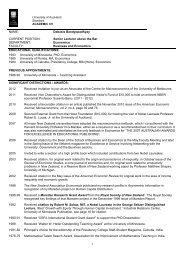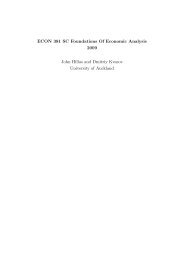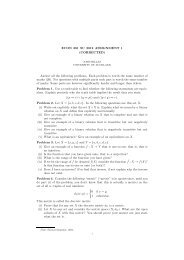ECON 381 SC 2012 ASSIGNMENT 1 ANSWERS Answer all the ...
ECON 381 SC 2012 ASSIGNMENT 1 ANSWERS Answer all the ...
ECON 381 SC 2012 ASSIGNMENT 1 ANSWERS Answer all the ...
You also want an ePaper? Increase the reach of your titles
YUMPU automatically turns print PDFs into web optimized ePapers that Google loves.
<strong>ECON</strong> <strong>381</strong> <strong>SC</strong> <strong>2012</strong> <strong>ASSIGNMENT</strong> 1<strong>ANSWERS</strong>JOHN HILLASUNIVERSITY OF AUCKLAND<strong>Answer</strong> <strong>all</strong> <strong>the</strong> following problems. Each problem is worth <strong>the</strong> same number ofmarks (20). For questions with multiple parts each part is worth <strong>the</strong> same numberof marks. Some parts are however significantly harder and longer than o<strong>the</strong>rs.Problem 1. Use a truth table to find whe<strong>the</strong>r <strong>the</strong> following statements are equivalent.Explain precisely why <strong>the</strong> truth table implies <strong>the</strong> result that you state.((p ⇒ r)∨(q ⇒ p)) and ((p∧q) ⇒ r).p q r ((p ⇒ r)∨(q ⇒ p)) ((p∧q) ⇒ r)T T T T TT T F T FT F T T TT F F T TF T T T TF T F T TF F T T TF F F T TWe see on <strong>the</strong> second line of <strong>the</strong> truth table that when p is true,q is true and r is false <strong>the</strong> first statement is true while <strong>the</strong> secondstatement is false. So <strong>the</strong>y are not logic<strong>all</strong>y equivalent. In fact <strong>the</strong>first statement is a tautology.Problem 2. Let X = {a,b,c,d,e}. In <strong>the</strong> following questions use this set X.(i) Write out explicitly what <strong>the</strong> set X×X is. Explain what we mean by a binaryrelation on X and define this explicitly and form<strong>all</strong>y.X ×X = {(a,a),(a,b),(a,c),(a,d),(a,e),(b,a),(b,b),(b,c),(b,d),(b,e),(c,a),(c,b),(c,c),(c,d),(c,e),(d,a),(d,b),(d,c),(d,d),(d,e),(e,a),(e,b),(e,c),(e,d),(e,e)}A binary relation on X expresses some relation among <strong>the</strong>members of X. We write xRy or (x,y) ∈ R to mean thatx has <strong>the</strong> relation R to y. Form<strong>all</strong>y a binary relation is anysubset of X ×X, including <strong>the</strong> empty set and <strong>all</strong> of X ×X.(ii) Give an example of a binary relation on X that is complete and one that isnot complete.Date: Second Semester, 2011.1
2 JOHN HILLAS UNIVERSITY OF AUCKLANDThere are many correct answers to this question. The essentialfeature of a correct answer is that for each pair of pointsx and y ei<strong>the</strong>r (x,y) or y,x should be in <strong>the</strong> set R. For exampleei<strong>the</strong>r (a,b) or (b,a) should be in <strong>the</strong> set. Since in ourdefinition of completeness we do not exclude <strong>the</strong> possibilitythat x = y we also require that for each possible value of x<strong>the</strong> pair (x,x) is in <strong>the</strong> set R. A relation is not complete if forsome pair of points x and y nei<strong>the</strong>r (x,y) nor (y,x) is in <strong>the</strong>set R. Perhaps <strong>the</strong> simplest, though not <strong>the</strong> most interestinganswers are that R = X × X is complete and R = ∅ is notcomplete. But <strong>the</strong>re are many o<strong>the</strong>r correct answers.(iii) Give an example of a binary relation that is transitive but not negativelytransitive.Again, <strong>the</strong>re are many correct answers. One particularlymeaningful one that we discussed in class was <strong>the</strong> strict preferencerelation for a consumer with threshold effect. Supposeor consumer likes earlier letters in <strong>the</strong> alphabet better thanlater letters, but in order to actu<strong>all</strong>y prefer one letter overano<strong>the</strong>rit must be at least two places earlier. Thus he prefersa to c but is indifferent between a and b. Such preferenceswould be described by <strong>the</strong> following relation:P = {(a,c),(a,d),(a,e),(b,d),(b,e),(c,e)}.This relation is transitive. The only possibility for x, y, andz <strong>all</strong> different with xPy and yPz is x = a, y = c and z = e,but in this case <strong>the</strong> condition for transitivity is met since wehave aPe, that is (a,e) is in P. However <strong>the</strong> relation is notnegatively transitive since we have aPc but have nei<strong>the</strong>r aPbnor bPc.Ano<strong>the</strong>r relation that is transitive but not negatively transitiveis given by any nontrivial equivalence. In our example“equals” is a natural example.I = {(a,a),(b,b),(c,c),(d,d),(e,e)}.Again, this is transitive. The only possibility for x, y, andz with xIy and yIz has x = y = z, but <strong>the</strong>n we also havexIz. It is not negatively transitive since we have aIa buthave nei<strong>the</strong>r aIb nor bIa.You can make slightly less trivial examples by having <strong>the</strong>consumer indifferent between some pairs of letters. ConsiderI = {(a,a),(a,b),(b,a),(b,b),(c,c),(c,d),(d,c),(d,d),(e,e)}.This relation too is transitive, but not negatively transitive.Proof for this case is left to you.(iv) Give an example of a binary relation that is negatively transitive but nottransitive.The notion of negative transitivity of a relation R is so c<strong>all</strong>edbecause it corresponds to <strong>the</strong> relation defined by notR beingtransitive. Thus each of <strong>the</strong> examples in <strong>the</strong> previous answergenerates an answer to this question. Simply take <strong>the</strong> complementof <strong>the</strong> relation in X ×X. So for P this would give
<strong>ECON</strong> <strong>381</strong> <strong>SC</strong> <strong>2012</strong> <strong>ASSIGNMENT</strong> 1 <strong>ANSWERS</strong> 3<strong>the</strong> relationnotP = X ×X\P = {(a,a),(a,b),(b,a),(b,b),(b,c),(c,a),(c,b),(c,c),(c,d),(d,a),(d,b),(d,c),(d,d),(d,e),(e,a),(e,b),(e,c),(e,d),(e,e)}This relation is not transitive since we have (a,b) and (b,c)in <strong>the</strong> relation but not (a,c). It’s a bit more tedious to seethat <strong>the</strong> relation is negatively transitive. For notP to benegatively transitive we require that if xnotPy <strong>the</strong>n ei<strong>the</strong>rxnotPz or znotPy. We see that <strong>the</strong>re are quite a few pairsin <strong>the</strong> relation notP. It would be very tedious to check eachcase that xnotPy. But we know that <strong>the</strong> condition will besatisfied as long as ei<strong>the</strong>r xnotPz or znotPy and it’s a loteasier to check <strong>the</strong> cases in which this does not happen. Forwhat values of x, y, and z do we have not ((xnotPz) or(znotPy)) that is (not(xnotPz)) and (not(znotPy))? From<strong>the</strong> definition of notP this is when xPz and zPy. As we sawin <strong>the</strong> answer to <strong>the</strong> previous question <strong>the</strong> only possibility forthis is x = a, z = c, and y = e. But <strong>the</strong>n (x,y) = (a,e) is inP and so is not in notP, and so for this combination of x, y,and z we do not require that ei<strong>the</strong>r xnotPz or znotPy. Thuswe have <strong>the</strong> condition “ei<strong>the</strong>r xnotPz or znotPy” wheneverrequired and so <strong>the</strong> relation notP is negatively transitive.Similarlywecouldgenerateexamplesfromanyof<strong>the</strong>o<strong>the</strong>ranswers to <strong>the</strong> previous question.(v) What is an equivalence? Give an example of an equivalence on X.An equivalence is a binary relation that is symmetric andtransitive. We gave a couple of examples in <strong>the</strong> answer toquestion (ii), namelyandI = {(a,a),(b,b),(c,c),(d,d),(e,e)}I = {(a,a),(a,b),(b,a),(b,b),(c,c),(c,d),(d,c),(d,d),(e,e)}.Since we have already seen that <strong>the</strong>se relations are transitivewe need only to check that <strong>the</strong>y are symmetric, that isthat when (x,y) is in <strong>the</strong> relation <strong>the</strong>n so is (y,x). This iscompletely trivial in <strong>the</strong> first case—<strong>the</strong> only pairs in <strong>the</strong> relationare of <strong>the</strong> form (x,x). In <strong>the</strong> second case <strong>the</strong> additionalpairs are (a,b) and (b,a) and (c,d) and (d,c). so we see thatwhenever (x,y) is <strong>the</strong>re <strong>the</strong>n so is (y,x), as required.Problem 3. Let X = {x,y,z} and Y = {a,b,c,d,e}(i) Give an example of a function f : X → Y that is one-to-one, that is, that isan injection.The requirement is that different points in X go to differentpoints in Y. There are many such functions. One is given byf(x) = a, f(y) = b, and f(z) = c.(ii) Is <strong>the</strong> function that you have given onto, that is, a surjection?
4 JOHN HILLAS UNIVERSITY OF AUCKLANDNo. ThereisnoelementofX thatmapstod. Weseethatthismust be <strong>the</strong> case whatever function we choose <strong>the</strong>re are onlythree points in X and each of <strong>the</strong>m maps to only one pointin Y. Since <strong>the</strong>re are 5 points in Y at least 2 of <strong>the</strong>m mustnot be images of any point in X. (Given that <strong>the</strong> function isassumed to be one-to-one exactly two of <strong>the</strong>m are not imagesof any point in X. In my answer d and e are not images ofany point in X.(iii) What is <strong>the</strong> range of <strong>the</strong> function you have given?The range of f, that is f(X) is {a,b,c}(iv) If we let <strong>the</strong> range of f be denoted f(X) consider <strong>the</strong> function ˜f : X → f(X)?Is this function one-to-one or onto (or both)?It’s one-to-one since <strong>the</strong> function f is one-to-one. It’s ontosince <strong>all</strong> points that are not images of some point in X havebeen left out of <strong>the</strong> co-domain.(v) Does ˜f have an inverse? If so find that inverse, if not explain why <strong>the</strong> inversedoes not exist.Yes. Being one-to-one and onto is a necessary and sufficientcondition for a function to have an inverse. ˜f−1 : f(X) → Xis given by ˜f −1 (a) = x, ˜f−1 (b) = y, and ˜f −1 (c) = z.Problem 4. Consider <strong>the</strong> following “metric” (“metric” is in quotes since, until youdo part (i) of <strong>the</strong> problem, you don’t know that this is actu<strong>all</strong>y a metric) on <strong>the</strong>set of <strong>all</strong> n−tuples of real numbers:{0 if x = y,d D (x,y) =1 o<strong>the</strong>rwise.This metric is c<strong>all</strong>ed <strong>the</strong> discrete metric.(i) Prove that for any set X <strong>the</strong> discrete metric d D is a metric.A function d : X ×X → R is a metric if for <strong>all</strong> x, y, and z inX1. d(x,y) ≥ 0 and d(x,y) = 0 if and only if x = y,2. d(x,y) = d(y,x),3. d(x,y) ≤ d(x,z)+d(z,y).If x = y <strong>the</strong>n d D (x,y) = 0 = d D (y,x) and if x ≠ y <strong>the</strong>nd D (x,y) = 1 = d D (y,x). This proves both properties 1 and2.If x = y <strong>the</strong>n d D (x,y) = 0 ≤ d D (x,z)+d D (z,y) by Property1,whichwe’vealreadyproved.Ifx ≠ y <strong>the</strong>nd D (x,y) = 1but we must have ei<strong>the</strong>r x ≠ z or y ≠ z (since if x = z andy = z <strong>the</strong>n x = y). But <strong>the</strong>n d D (x,z) + d D (z,y) is ei<strong>the</strong>r1 + 0 = 1 or 0 + 1 = 1 or 1 + 1 = 2, and, in any cased D (x,y) = 1 ≤ d D (x,z) + d D (z,y). Hence Property 3 issatisfied.(ii) Let X be any set and consider <strong>the</strong> metric space (X,d D ). What are <strong>the</strong> opensubsets of X with this metric? You should prove your answer not just statewhat <strong>the</strong> set is.What are <strong>the</strong> open b<strong>all</strong>s with metric d D ? If <strong>the</strong> radius r isgreaterthan 1 <strong>the</strong>n for any x ∈ X is distance less than r fromx so every point in X is in <strong>the</strong> b<strong>all</strong>. If <strong>the</strong> radius is less thanor equal to 1 <strong>the</strong>n onlyx is distance less than r from x. That
<strong>ECON</strong> <strong>381</strong> <strong>SC</strong> <strong>2012</strong> <strong>ASSIGNMENT</strong> 1 <strong>ANSWERS</strong> 5isB r (x) ={{x} if r ≤ 1X if r > 1 .Now let S ⊂ X and let x ∈ S. Then <strong>the</strong>re is some r > 0,namely r = 1 (or any positive value less than 1), such thatB r (x) = {x} ⊂ S. Thus S is an open set.We have shown that any set S ⊂ X is open. The open setsare <strong>all</strong> <strong>the</strong> subsets of X.Notice that we didn’t make any assumptions about <strong>the</strong> setX. We can define <strong>the</strong> discrete metric on any set and withthat metric <strong>all</strong> <strong>the</strong> subsets of our set are open. This usu<strong>all</strong>yisn’t a particularly useful structure to put on <strong>the</strong> set.Problem 5. Let (X,d) be a metric space.Ano<strong>the</strong>r approach to putting structure of a set X is to directly specify <strong>the</strong> opensets. Such a space is c<strong>all</strong>ed a topological space. If (X,τ) is a topological space <strong>the</strong>nX is a set and τ is a collection of subsets of X such that1. X ∈ τ2. ∅ ∈ τ3. If A and B are in τ <strong>the</strong>n A∩B is in τ. That is, <strong>the</strong> intersection of two elementsof τ is in τ. (This also implies that <strong>the</strong> intersection of any finite number ofelements of τ is in τ.)4. If A n is in τ for every n ∈ N for some set N that might be finite or infinite <strong>the</strong>n∪ n∈N A n is in τ. That is, <strong>the</strong> union of any number of elements of τ is in τ.Now let X = {a,b,c,d,e}. For <strong>the</strong> questions below use this particular set X.(i) Show that for any metric d <strong>the</strong> set of open subsets of X are <strong>the</strong> same. Findwhat this collection of open sets is.In <strong>the</strong> previous problem we considered a general set butlooked at a particular metric for each possible set. In thisproblem we look at a particular set X but ask about <strong>all</strong> possiblemetrics. The essential feature of <strong>the</strong> set we consider isthat it contains only a finite number of elements—in our casefive. We essenti<strong>all</strong>y find <strong>the</strong> same result. All sets are open.And <strong>the</strong> reasoningis quite similar. Let us consider some metricd on X. For any x and y in X with x ≠ y d(x,y) > 0.Consider s = min x,y∈X|x≠y d(x,y), that is <strong>the</strong> sm<strong>all</strong>est distancebetween elements of X o<strong>the</strong>r than <strong>the</strong> distance fromeach point to itself. This is <strong>the</strong> sm<strong>all</strong>est of a finite umberof strictly positive numbers and so s > 0 and if x ≠ y <strong>the</strong>nd(x,y) ≥ s. Thus for any x ∈ X = {a,b,c,d,e} we haveB s (x) = {x}. Now, as in <strong>the</strong> previous problem, let S ⊂ Xand let x ∈ S. Then <strong>the</strong>re is some r > 0, namely r = s (orany positive value less than s), such that B r (x) = {x} ⊂ S.Thus S is an open set. Again <strong>the</strong> set of open sets is <strong>the</strong> collectionof <strong>all</strong> subsets of X. (Of course in this case we knowwhat X is so we know what <strong>the</strong> set of <strong>all</strong> subsets is. Thereare 32 of <strong>the</strong>m, including <strong>the</strong> empty set.(ii) Show that if we let τ = {X,∅} that this collection of “open sets” satisfies <strong>the</strong>four properties given above.This is quite an easy problem. The only difficulty is beingpedantic enough to find something to say. Here is a fairlycomplete answer. Since X ∈ {X,∅} Property 1 is satisfied.
6 JOHN HILLAS UNIVERSITY OF AUCKLANDSince ∅ ∈ {X,∅} Property 2 is satisfied. For any A,B ∈{X,∅} if A = B = X <strong>the</strong>n A∩B = X ∈ {X,∅}. O<strong>the</strong>rwiseat least one of A and B are ∅ and <strong>the</strong>n A∩B = ∅ ∈ {X,∅}.So, in <strong>all</strong> cases, if A,B ∈ {X,∅} <strong>the</strong>n A ∩ B ∈ {X,∅} soProperty 3 is satisfied. Now suppose that for some collectionof sets {A n | n ∈ N} with A n ∈ {X,∅} for <strong>all</strong> n. Each A n isei<strong>the</strong>r ∅ or X. If A n = ∅ for <strong>all</strong> n <strong>the</strong>n ∪ n∈N A n = ∅ ∈ {X,∅}.If not <strong>the</strong>n A n ≠ ∅ for at least one n and for that n it must bethat A n = X. But <strong>the</strong>n ∪ n∈N A n = X ∈ {X,∅}. So Property4 is satisfied.(iii) Show that this topology cannot come from any metric. (Hint: you haveessenti<strong>all</strong>y already show this in your answer to part (i).)In part (i) we saw that whatever metric we use <strong>the</strong> collectionof open sets is <strong>all</strong> subsets of {a,b,c,d,e}. There are 32 suchopen sets. The topology τ = {X,∅} is not this collection soit cannot come from any metric.(iv) Give ano<strong>the</strong>r set τ that satisfies <strong>the</strong> four properties given above.There are many such τ. Here are a few examples:τ = {X,{a},∅}τ = {X,{a,b},∅}τ = {X,{a},{a,b},∅}τ = {X,{a},{b},{a,b},∅}τ = {X,{a},{b},{a,b},{a,b,c},∅}τ = {X,{c},{a,b,c},{c,d,e},∅}(v) Characterise <strong>the</strong> set of <strong>all</strong> possible topologies τ on X that satisfy <strong>the</strong> fourproperties.Looking at <strong>the</strong> examples I gave in <strong>the</strong> previous part you seesome difficulties if you try to give a very explicit characterisationvery far away from simply “applying <strong>the</strong> properties.”Here is one characterisation. There are 32 subsets of X.The collection must include ∅ and X. You can include anyof <strong>the</strong> o<strong>the</strong>r 30 subsets. Then add <strong>all</strong> intersection of subcollectionsof <strong>the</strong> sets you have added and <strong>all</strong> unions of subcollectionsof <strong>the</strong> sets you have added. The resulting collectionwill satisfy <strong>the</strong> axioms and <strong>all</strong> collections satisfying <strong>the</strong>axioms can be obtained in this way.









